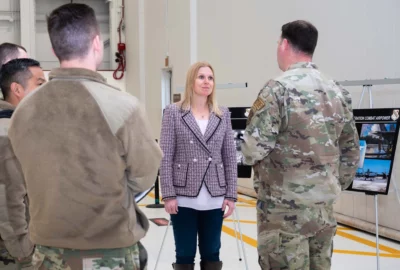

The Pentagon says the priorities for DEOS are to develop, deliver and maintain the classified DOD O365 platform, and continue ongoing sustainment of the...
The build up to the Defense Enterprise Office Solutions contract vehicle, starting in 2015, was full of anticipation and promise.
Before the award of this contract that many estimated to be worth $8 billion-to-$10 billion, Defense Department technology and program executives said the effort will “better align our resources,” it has the “potential to dramatically change the way the Army does business,” and it would “eliminate some barriers to collaboration, and also help to eliminate duplicative spending.”
The Department of Navy was writing its multibillion-dollar Next Generation Enterprise Network (NGEN) contract at the time, and specifically took steps so it could easily move its email and collaboration capabilities to DEOS.
There even was talk of using DEOS as a model for a civilian agency version, called CEOS.
But here we are eight years after the Defense Information Systems Agency first came up with the idea, and two-plus years since the 10-year, $4.4 billion award to General Dynamics Information Technology (GDIT) for implementation services, DEOS is struggling to live up to expectations.
Former DoD executives and industry sources say the program isn’t necessarily a failure and is providing some value. But the shortcomings of DEOS is a case of how time and circumstances may have overtaken the initial rationale of the program, leaving many of the services to have found better and cheaper ways to accomplish the same goals.
“How people are using office and collaboration tools now versus before the pandemic is hugely different. It was hard when we were developing DEOS to foresee how much things would change,” said Alan Thomas, the former commissioner of the Federal Acquisition Service in the General Services Administration, which worked with DISA to run the acquisition. “We all know how the ground shifted under the DEOS program because of the pandemic, maybe in more ways than we saw in a lot of other areas, as we were all driven out of the office.”
DoD data about DEOS shows it hasn’t lived up to expectations. Back in 2018, DISA hoped to start migrating the department’s first users — about 1.5 million of them — within 18 months after award.
Navy Cmdr. Jessica McNulty, a DoD spokesperson, said under the DEOS blanket purchase agreement, services and agencies have bought about 98,000 subscription licenses and 323,000 Azure Active Directory Premium 2 (AADP2) licenses for Office 365.
McNulty added in all there are 1.97 million subscription licenses sold since 2020.
The difference, according to an industry source with knowledge of how DEOS works, is the 98,000 number is likely only for the joint tenant — the DISA-managed instance of O365 that serves users in DoD’s “fourth estate,” while the 1.97 million number includes the assorted other tenants the military services wound up creating, which, in many ways, was what DoD was attempting to avoid by creating the DEOS contract in the first place.
“DEOS was intended to be one-stop shop and the ‘be all, end all’ for these collaboration tools. But what happened was the services stood up these other tenants as well as several other contracts outside of DEOS,” said the source, who requested anonymity because their company still does business with DoD. “DEOS ended up being one of many contracts, and like many DISA programs, the ‘build it and they will come’ philosophy didn’t work well.”
McNulty confirmed there are 14 unclassified O365 tenants across DoD.
“We’ve allowed for this many tenants given the desire by the military services and others to manage their own DoD O365 environments, based on their concerns about oversight of their own data and security,” she said. “However, now that we’re nearly two years into our impact level 5 (IL5) DoD O365 journey, we’ve all recognized that 14 tenants is too many; at the same time, one is too few, as it would likely be the largest O365 tenant in the world. We are working to reach a balance between the two numbers in the future.”
At the same time, she said DoD also is planning to authorize the O365 instance in the IL6 or the classified environment where it plans a single, joint tenant.
The industry source said DoD’s multiple unclassified tenants had integration and interoperability issues because the services set up different rules and requirements.
It seems that the DoD Chief Information Officer, John Sherman, is trying to avoid the same mistakes with the classified tenant.
At the heart of the shortcomings with DEOS isn’t the multiple tenants or the inconsistent implementation of O365, it’s the price of the licenses DISA and its industry partner Dell are selling through the BPA.
Multiple former government sources and industry experts say the price negotiated through the DEOS contract for O365 licenses is as much as 20% higher than what the services and Defense agencies could get through the Navy enterprise software initiative (ESI) contract.
A former DoD technology executive, who requested anonymity because their current company does business with the government, said the overhead of the DEOS program was “exceptionally absurd and didn’t add value.”
“DEOS was put in place before the Commercial Virtual Remote (CVR) platform, and before they knew how folks would consume the platform. They went massively huge before having any data about how users would consume software-as-a-service,” the former executive said. “Why they didn’t start small and then grow it is a big question. But now they are eating their results.”
Sources say the huge markup is based on how DoD thought it wanted to use the licenses in 2016 or 2017.
“GSA and DoD only wanted to buy licenses on a monthly basis because they wanted a rebate if people leave or move to a new job. But that approach causes Dell to pay up front for a years’ worth of licenses,” the industry source said. “GSA was not flexible with this approach, so Dell is having to pay upfront for all those licenses, which caused the price to be much higher than what Microsoft was charging others.”
The former DoD executive said the price for O365 licenses was “insane,” and the services were required to buy licenses for every employee whether or not they were using the product in the same way.
All of the military services took steps to move away from DEOS or find cheaper Microsoft licenses.
Air Force CIO Lauren Knausenberger said recently one of the ways she found to save money was by redoing several different deals with software vendors.
“We renegotiated a number of enterprise software deals, where we saved very large amounts of money. This year, we renegotiated some of our Office 365 licenses and that actually took care of a lot of our under use going into the year. There are places where we had to get smarter with negotiations, and then there were places where we had to cut. There were places where we just had to find the money,” Knausenberger said.
The Army went in a different direction last October by moving 250,000 active duty enlisted soldiers to Google Workspace.
Sources say that decision helped convince Microsoft to drop its price for O365 licenses by half in some cases on other non-DEOS contracts.
The idea, according to sources, is new recruits know how to use Google Workspace, it’s more intuitive and in some ways, provides better security.
The Navy launched Operation Flank Speed, where it plans to move more than 650,000 sailors, seamen and Marines into the O365 environment.
Microsoft declined to comment for the story. GDIT also declined to comment for the story.
“What the Navy did was they looked at this DEOS problem and perhaps learned from previous contracts, or did more research and decided to buy on yearly basis and not get up-charged,” said another former DoD official with knowledge of DISA and the DEOS contract. “The former Army CIO [Raj Iyer] looked for alternatives and one was Google because there are some junior service members who don’t use O365 on a daily basis as part of their primary mission. It didn’t make sense to pay for the full suite for them. I do think the Army looked at this problem and made innovative decisions. Hopefully other services are looking at that as well, because they have to answer the question: Does every service member require the Cadillac of IT, or can they do with something to get email, to receive notifications?”
McNulty, the DoD spokesperson, said the price differences between DEOS and the Navy’s ESI did not affect the implementation of DEOS.
“The DEOS BPA and the Navy ESI provide different models to purchase O365 licenses. The Office of the DoD CIO (OCIO) does not provide differentiating guidance on licensing,” she said. “However, OCIO must ensure every DoD component keeps current appropriate licenses to maintain O365 collaboration capabilities. For mission partners that have consistent licensing requirements year-over-year, the Navy contract offers cost savings due to the annual payment-up-front model. The department has various options available to mission partners for purchasing licenses and savings, which will vary based on the contract option they chose that best meets their mission needs.”
McNulty said DoD has no plans to end the DEOS BPA. At the same time, expanding the unclassified joint tenant version of DEOS also doesn’t seem to be a major priority.
“DoD’s main priority for 2023 is to develop, deliver and maintain the classified DOD O365 platform,” she said. “Other priorities include continuing ongoing sustainment of the unclassified joint environment and evolution of disrupted, disconnected, intermittent and low-bandwidth (DDIL) environment. Lastly, DoD is continuing to assist mission partners in optimizing the BPA for services they may need including data migrations, engineering support and zero trust modernization.”
There was no mention of expanding the number of users under DEOS despite specifically being asked that question.
Sources say the expansion most likely will come through the Navy ESI contract because the idea of paying for monthly licenses, especially if the markup is as much as 20%, isn’t tenable for the services.
“It sounds like the DoD CIO is saying ‘the Navy contract is much cheaper, but we are not telling you what to do,’” the industry source said. “It sounds like they don’t want to throw GSA under the bus, but it’s clear no one wants a monthly license and to have to pay that premium.”
Multiple sources agreed that part of the problem with DEOS, and in many ways many of DISA’s offerings, has to do with the time it takes to develop the requirements, award the contract, getting through protests, and then implementation. Due to that elongated timeline, particularly in the case of DEOS, the technology environment changes, leaving customers wanting something different than what DISA is offering.
“There is an element that agencies have more experience with the cloud now that they are several years into it. DISA completed all transitions during COVID to DEOS, but more than that, it looks to me like DISA made poor assumptions up front about what kinds of pricing models they would get from vendors,” the second former DoD executive said. “I think they thought it was a good assumption that if you can get the licenses on a monthly basis, it should be cheaper. But clearly they didn’t do enough research. It seems like the government made poor assumptions on what would be a good pricing model, and that should’ve been one of those things teased out of market research.”
McNulty said DoD recognized how the pandemic changed the adoption of O365 capabilities. But the DEOS BPA has had only one administrative modification to date.
Copyright © 2025 Federal News Network. All rights reserved. This website is not intended for users located within the European Economic Area.
Jason Miller is executive editor of Federal News Network and directs news coverage on the people, policy and programs of the federal government.
Follow @jmillerWFED


